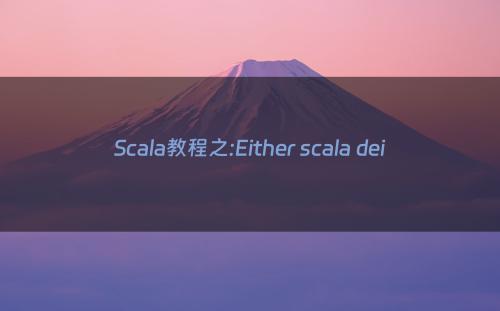网站首页 > 基础教程 正文
在之前的文章中我们提到了Option,scala中Option表示存在0或者1个元素,如果在处理异常的时候Option就会有很大的限制,因为Option如果返回None,那么我并不知道具体的异常到底是什么,这样scala引入了Either。
顾名思意,Either表示或者是这一个元素或者是那个元素。这样在异常处理的时候就非常有用了。

我们先看一下Either的定义:
sealed abstract class Either[+A, +B] extends Product with Serializable
它有两个子类Left和Right:
/** The left side of the disjoint union, as opposed to the [[scala.util.Right]] side.
*
* @author <a href="mailto:research@workingmouse.com">Tony Morris</a>, Workingmouse
*/
final case class Left[+A, +B](@deprecatedName('a, "2.12.0") value: A) extends Either[A, B] {
def isLeft = true
def isRight = false
@deprecated("Use .value instead.", "2.12.0") def a: A = value
}
/** The right side of the disjoint union, as opposed to the [[scala.util.Left]] side.
*
* @author <a href="mailto:research@workingmouse.com">Tony Morris</a>, Workingmouse
*/
final case class Right[+A, +B](@deprecatedName('b, "2.12.0") value: B) extends Either[A, B] {
def isLeft = false
def isRight = true
@deprecated("Use .value instead.", "2.12.0") def b: B = value
}
我们通过这两个子类从两个可能的元素中选择一种。
Either 概念的产生时间早于Scala。很长时间以来它被认为是抛出异常的一种替代方案。为了尊重历史习惯,当Either 用于表示错误标志或某一对象值时,Left 值用于表示错误标志,如:信息字符串或下层库抛出的异常;而正常返回时则使用Right 对象。很明显,Either 可以用于任何需要持有某一个或另一个对象的场景中,而这两个对象的类型可能不同。
我们看下怎么用Either的常规使用:
def positive(i: Int): Either[String,Int] =
if (i > 0) Right(i) else Left(s"nonpositive number $i")
for {
i1 <- positive(5).right
i2 <- positive(10 * i1).right
i3 <- positive(25 * i2).right
i4 <- positive(2 * i3).right
} yield (i1 + i2 + i3 + i4)
// Returns: scala.util.Either[String,Int] = Right(3805)
for {
i1 <- positive(5).right
i2 <- positive(-1 * i1).right // EPIC FAIL!
i3 <- positive(25 * i2).right
i4 <- positive(-2 * i3).right // EPIC FAIL!
} yield i1 + i2 + i3 + i4
// Returns: scala.util.Either[String,Int] = Left(nonpositive number -5)
再看一下Either怎么在代码中消除程序错误,将错误封装在Either中。
scala> def addInts(s1: String, s2: String): Int =
| s1.toInt + s2.toInt
addInts: (s1: String, s2: String)Int
scala> for {
| i <- 1 to 3
| j <- 1 to i
| } println(s"$i+$j = ${addInts(i.toString,j.toString)}")
1+1 = 2
2+1 = 3
2+2 = 4
3+1 = 4
3+2 = 5
204 | 第7 章
3+3 = 6
scala> addInts("0", "x")
java.lang.NumberFormatException: For input string: "x"
先看上面的例子,我们定义了一个addInts方法,接收两个String参数,并将其转换为Int。如果两个参数都是可以转换的字符串当然没问题,但是如果输入了一个无法转换的字符串就会报异常。
虽然异常有时候是好事情,但是异常会阻止程序的正常运行。我们看下怎么用Either来将其封装起来:
scala> def addInts2(s1: String, s2: String): Either[NumberFormatException,Int]=
| try {
| Right(s1.toInt + s2.toInt)
| } catch {
| case nfe: NumberFormatException => Left(nfe)
| }
addInts2: (s1: String, s2: String)Either[NumberFormatException,Int]
scala> println(addInts2("1", "2"))
Right(3)
scala> println(addInts2("1", "x"))
Left(java.lang.NumberFormatException: For input string: "x")
scala> println(addInts2("x", "2"))
Left(java.lang.NumberFormatException: For input string: "x")
按照上面的设计,Either封装好了异常,不会影响程序的正常运行,而且可以返回具体的错误信息,实在是一个不错的设计方式。
欢迎关注我的公众号:程序那些事,更多精彩等着您!
更多内容请访问:flydean的博客 flydean.com
猜你喜欢
- 2024-10-12 Scala初学者入门指南!涵盖20多个基本技巧
- 2024-10-12 Scala循环性能问题,为了性能,你愿意牺牲代码的可维护性么?
- 2024-10-12 使用Apache Kafka时的7个错误 apache kafka实战pdf
- 2024-10-12 scala中为什么不建议用return scala for until
- 2024-10-12 scala——泛型方法、类、特质的使用,泛型边界、协变逆变非变
- 2024-10-12 程序员构建总是出问题,怎么办? 程序员构建总是出问题,怎么办呢
- 2024-10-12 scala——列表、元祖、列表相关知识
- 2024-10-12 scala语言基础图解-第一阶段(变量-条件-循环-方法-函数-集合)
- 2024-10-12 Scala入门视频已更新至88讲,后续还有大约20讲左右的视频就结束
- 2024-10-12 Scala快速入门 - 环境安装篇 scala安装步骤
- 最近发表
- 标签列表
-
- gitpush (61)
- pythonif (68)
- location.href (57)
- tail-f (57)
- pythonifelse (59)
- deletesql (62)
- c++模板 (62)
- css3动画 (57)
- c#event (59)
- linuxgzip (68)
- 字符串连接 (73)
- nginx配置文件详解 (61)
- html标签 (69)
- c++初始化列表 (64)
- exec命令 (59)
- canvasfilltext (58)
- mysqlinnodbmyisam区别 (63)
- arraylistadd (66)
- node教程 (59)
- console.table (62)
- c++time_t (58)
- phpcookie (58)
- mysqldatesub函数 (63)
- window10java环境变量设置 (66)
- c++虚函数和纯虚函数的区别 (66)
